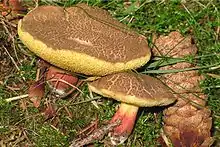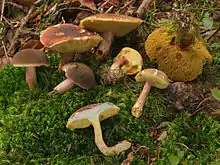Xerocomellus
Xerocomellus is a genus of fungi in the family Boletaceae. The genus, as it was described in 2008, contained 12 species.[1] However X. rubellus and X. engelii were transferred to the new genus Hortiboletus and X. armeniacus was transferred to the new genus Rheubarbariboletus in 2015.[2][3] Molecular analysis supports the distinction of Xerocomellus species from Boletus and Xerocomus, within which these species were formerly contained. Xerocomellus in fact is only distantly related to Xerocomus and is most closely related to Tylopilus, Boletus sensu stricto, Porphyrellus, Strobilomyces, and Xanthoconium.[4]
| Xerocomellus | |
|---|---|
 | |
| Xerocomellus chrysenteron | |
| Scientific classification | |
| Domain: | Eukaryota |
| Kingdom: | Fungi |
| Division: | Basidiomycota |
| Class: | Agaricomycetes |
| Order: | Boletales |
| Family: | Boletaceae |
| Genus: | Xerocomellus Šutara (2008) |
| Type species | |
| Xerocomellus chrysenteron (Bull.) Šutara (2008) | |
| Species | |
|
See text | |
Taxonomy
Members of the genus had been classified either in the genus Boletus or Xerocomus until Czech mycologist Josef Šutara examined a number of species and concluded that there was a defined group containing X. chrysenteron, X. armeniacus and relatives that are distinct morphologically from the group containing Xerocomus subtomentosus and related species. He deferred fully delimiting the genus until genetic work confirmed their distinctness.[1] Previously, Manfred Binder had coined the term Paraxerocomus for the group but this was not officially published.[1]
The type species is the red-cracked bolete (Xerocomellus chrysenteron).[1]
Genetic analysis published in 2013 showed that X. chrysenteron and X. zelleri form a Xerocomellus clade within a larger group informally called "anaxoboletus" in the Boletineae. It appears to have affinities with what was then known informally as the "rubellus clade", which contained the species X. rubellus and X. armeniacus, now known as Hortiboletus rubellus and Rheubarbariboletus armeniacus respectively.[2] The same study found Xerocomellus to be more distantly to a 'badius' clade containing Boletus badius, now known as Imleria badia, and relatives.[5] Other clades in the group include the porcini (true Boletus species) and Strobilomyces clades, species currently designated Xerocomus (the species are not true Xerocomus species), and smaller genera whose relationships are unclear.[4]
Description
Members of the genus have small to medium-size fruit bodies with more slender stipes compared with other boletes. They are often brightly coloured.[1] The caps are dry and do not become sticky when wet. Their cuticle tissue is a palisadoderm, comprising parallel or roughly parallel hypha arranged in an anticlinal fashion. The palisoderm, which is generally between 120 and 350 μm thick (although extremes of 80 μm and 500 μm are known), maintains its characteristic arrangement for longer periods than other boletes. The tubes are generally yellow and adnate or slightly decurrent. The pores are also yellow and quite large, up to 2.5 mm in diameter each and angular in shape. The spores are generally spindle-shaped to oval and have a smooth or striate surface. The spore print is brown or slightly olive-tinged when fresh.[1]
Morphological Features of Xerocomoid Boletes[1][6][7]
| Boletus s.str. | Hemileccinum | Xerocomellus | Xerocomus s.str. | |
|---|---|---|---|---|
| Spore surface | Smooth | Smooth | Longitudinally striated or smooth, never bacilate | Bacilate |
| Hymenophoral trama | Boletoid type with gelatinous lateral strata | Boletoid type with gelatinous lateral strata | Intermediate between boletoid and phylloporoid when fully developed with distinct but weakly gelatinous lateral strata | Phylloporoid type with nongelatinous lateral strata |
| Pileipellis | Trichoderm, sometimes collapsing, rarely ixotrichoderm or other | Initially trichoderm but collapses with age | Initially palisadoderm, typically encrusted | Initially a trichoderm, never encrusted |
| Lateral stipe stratum | Frequently gelatinous, 60–90 μm thick, thicker than that of Xerocomellus | Similar to that of Leccinum species, ornamented with stipe scabrousities up to 400–640 μm thick | Frequently not present, reduced to no more than 30–40 μm thick, not gelatinous | Lateral stipe stratum never gelatinous and 80–200 μm thick |
Ecology
Xerocomellus species form mycorrhizal associations with coniferous and deciduous trees.[1]
Species
| Image | Scientific Name | Taxon author | Year | Basionym | Distribution |
|---|---|---|---|---|---|
| X. amylosporus | (A.H. Sm.) J.L. Frank & N. Siegel, | 2020 | Porphyrellus amylosporus A.H. Sm., (1965). | Vancouver Island, British Columbia, Canada, south into California | |
| X. atropurpureus | J.L. Frank, N. Siegel & C.F. Schwarz, | 2020 | British Columbia south at least to Monterey County, California along the coast, inland to the Sierra Nevada and Cascade Range | ||
| X. behrii | (Harkn.) Castellano, M.E. Sm. & J.L. Frank | 2018 | Splanchnomyces behrii Harkn., (1884). | California and Oregon | |
 |
X. chrysenteron | (Bull.) Šutara | 2008 | Boletus chrysenteron Bull. (1791)[8] | Taiwan |
_Watling_%2526_A.E._Hills_254673.jpg.webp) |
X. cisalpinus | (Simonini, H.Ladurner & Peintner) Klofac[9] | 2011 | Xerocomus cisalpinus Simonini, H. Ladurner & Peintner (2003)[10] | mainland Europe and in North America. |
| X. diffractus | N. Siegel, C.F. Schwarz, & J.L. Frank | 2020 | central California, through the Pacific Northwest into British Columbia, Canada, east to the Rocky Mountains of Wyoming, and south into Arizona | ||
_Singer_14.jpg.webp) |
X. dryophilus | (Thiers) N. Siegel, C.F. Schwarz & J.L. Frank | 2014 | Boletus dryophilus Thiers | North America. |
| X. fennicus | (Harmaja) Šutara | 2008 | Boletellus fennicus Harmaja (1999)[11] | Austria, Czech Republic, Denmark, Finland and Sweden, possibly also Belgium | |
| X. macmurphyi | (Zeller & C.W. Dodge) Castellano, Saylor, M.E. Sm., & J.L. Frank | 2018 | Hymenogaster macmurphyi Zeller & C.W. Dodge, 1934. | California and Oregon | |
_%C5%A0utara_309306.jpg.webp) |
X. marekii | (Šutara & Skála) Šutara | 2008 | Boletus marekii Šutara & Skála (2007)[12] | Czech Republic and Hungary |
 |
X. mendocinensis | (Thiers) N. Siegel, C.F. Schwarz & J.L. Frank | 2020 | Boletus truncatus (Singer, Snell, & Dick) Pouzar | Western United States |
 |
X. perezmorenoi | Martínez-Reyes M, Carrera-Martínez A... | 2023 | Mexico | |
_Contu_309289.jpg.webp) |
X. porosporus | (Imler ex G.Moreno & Bon) Šutara | 2008 | Boletus porosporus Imler ex Bon & G.Moreno (1977)[14] | Europe |
 |
X. pruinatus | (Fr. & Hök) Šutara | 2008 | Boletus pruinatus Fr. & Hök (1835)[15] | Europe |
| X. rainisiae | (Bessette & O.K. Mill.) N. Siegel, C.F. Schwarz & J.L. Frank | 2014 | Boletus rainisiae Bessette & O.K. Mill. [as “rainisii”], in Bessette et al., 2000. | Vancouver Island, British Columbia, Canada, south into Oregon. | |
_%C5%A0utara_350064.jpg.webp) |
X. ripariellus | (Redeuilh) Šutara | 2008 | Xerocomus ripariellus Redeuilh (1997)[16] | Europe |
| X. salicicola | C.F. Schwarz, N. Siegel & J.L. Frank | 2020 | Xerocomus salicicola C.F. Schwarz, N. Siegel & J.L. Frank (2020)[17] | Western North America | |
| X. truncatus | (Singer, Snell & E.A.Dick) Klofac[9] | 2011 | Xerocomus truncatus Singer, Snell & E.A.Dick (1959)[18] | Eastern North America | |
.jpg.webp) |
X. zelleri | (Murrill) Klofac 2011[9] | 2011 | Ceriomyces zelleri Murrill (1912)[19] | Northwestern North America |
References
- Šutara J. (2008). "Xerocomus s. l. in the light of the present state of knowledge" (PDF). Czech Mycology. 60 (1): 29–62. doi:10.33585/cmy.60104.
- Vizzini A. (26 June 2015). "Nomenclatural novelties" (PDF). Index Fungorum: 1. ISSN 2049-2375.
- Biketova, Alona Yu. (2 September 2015). "Nomenclatural novelties" (PDF). Index Fungorum (257): 1. ISSN 2049-2375.
- Nuhn ME, Binder M, Taylor AF, Halling RE, Hibbett DS (2013). "Phylogenetic overview of the Boletineae". Fungal Biology. 117 (7–8): 479–511. doi:10.1016/j.funbio.2013.04.008. PMID 23931115.
- Vizzini A. (12 June 2014). "Nomenclatural novelties" (PDF). Index Fungorum (147): 1. ISSN 2049-2375.
- Šutara, J. (1989). "The delimitation of the genus Leccinum". Ceská Mykologie. 43: 1–12.
- Šutara J. (1991). "Pseudoboletus, a new genus of Boletales". Ceská Mykologie. 45 (1–2): 1–9.
- Bulliard JBF. (1791). Herbier de la France (in French). Vol. 11. plate 490.3.
- Klofac W. "Rotfußröhrlinge (Gattung Xerocomellus) in aktueller Sicht". Österreichische Zeitschrift für Pilzkunde (in German). 20: 35–43.
- Peintner U, Ladurner H, Simonini G (2003). "Xerocomus cisalpinus sp. nov., and the delimitation of species in the X. chrysenteron complex based on morphology and rDNA-LSU sequences". Mycological Research. 107 (6): 659–79. doi:10.1017/S0953756203007901. PMID 12951793.
- Harmaja H. (1999). "Boletellus fennicus, a new species from Finland". Karstenia. 39 (2): 37–8. doi:10.29203/ka.1999.335.
- Šutara J, Skála E (2007). "Boletus marekii, a new species with truncate spores from the Boletus chrysenteron group" (PDF). Czech Mycology. 59 (1): 11–24. doi:10.33585/cmy.59103.
- MartíNez-Reyes, Magdalena; Carrera-MartíNez, Anaitzi; De La Fuente, Javier Isaac; RíOs-GarcíA, Uzziel; Ortiz-Lopez, Ivette; Ayala-VáSquez, Olivia (2023-02-14). "Xerocomellus perezmorenoi (Boletaceae, Boletales), a new edible species from Mexico". Phytotaxa. 584 (2). doi:10.11646/phytotaxa.584.2.3. ISSN 1179-3163.
- Moreno G. (1977). "Nouveaux taxons de la famille Boletaceae Chev. trouvés en Espagne". Documents Mycologiques (in French). 7: 27–8.
- Fries EM, Hök CT. Boleti, fungorum generis, illustratio (in Latin). Uppsala. p. 9.
- Redeuilh G. (1997). "Xerocomus ripariellus Redeuilh". Documents Mycologiques. 26 (104): 30–1.
- "Xerocomellus (Boletaceae) in western North America: Ingenta Connect". Home. Retrieved 2021-01-29.
- Snell WH, Singer R, Dick EA (1959). "Notes on boletes. XI". Mycologia. 51 (4): 564–77. doi:10.2307/3756143. JSTOR 3756143.
- Murrill WA. (1912). "Polyporaceae and Boletaceae of the Pacific Coast". Mycologia. 4 (2): 91–100. doi:10.2307/3753546. JSTOR 3753546.
External links
- Xerocomellus in Index Fungorum
 Media related to Xerocomellus at Wikimedia Commons
Media related to Xerocomellus at Wikimedia Commons